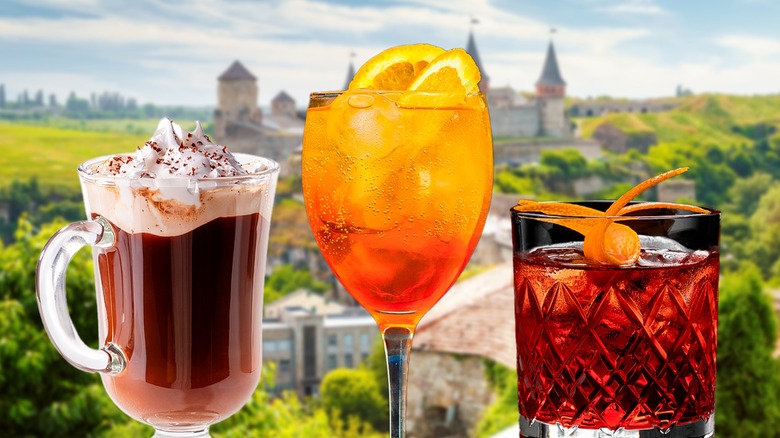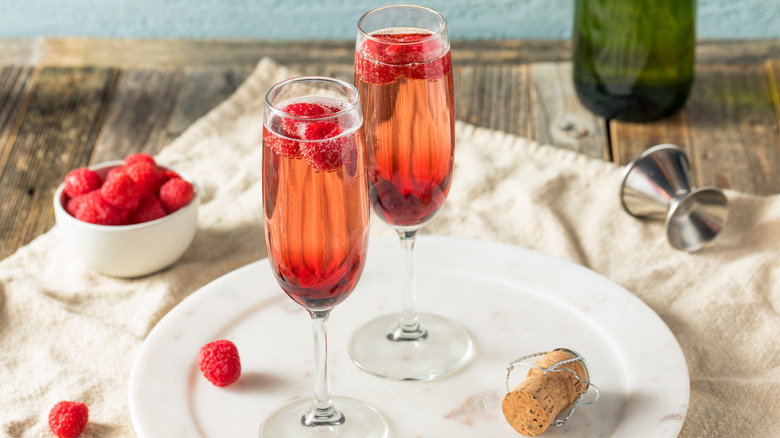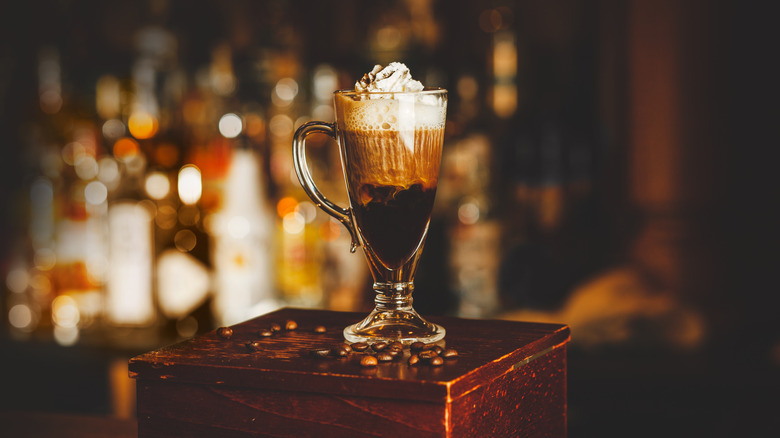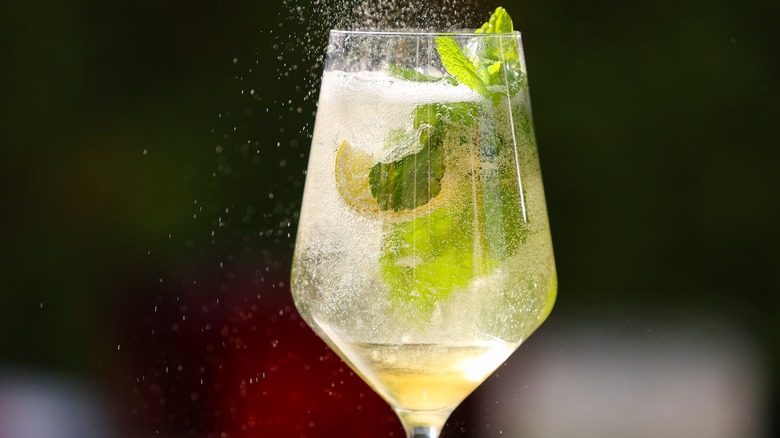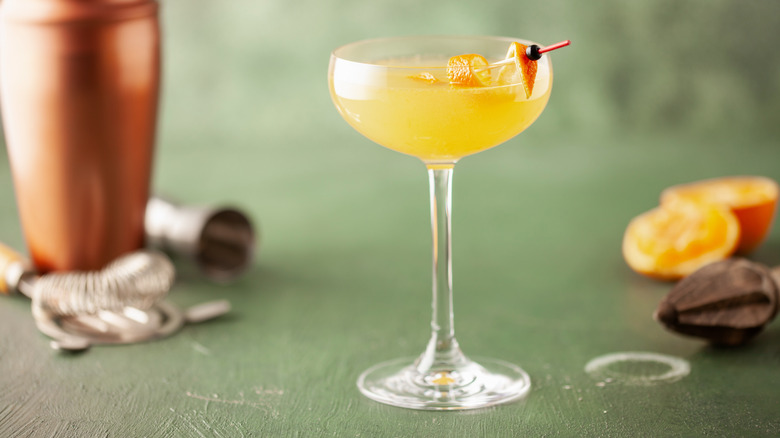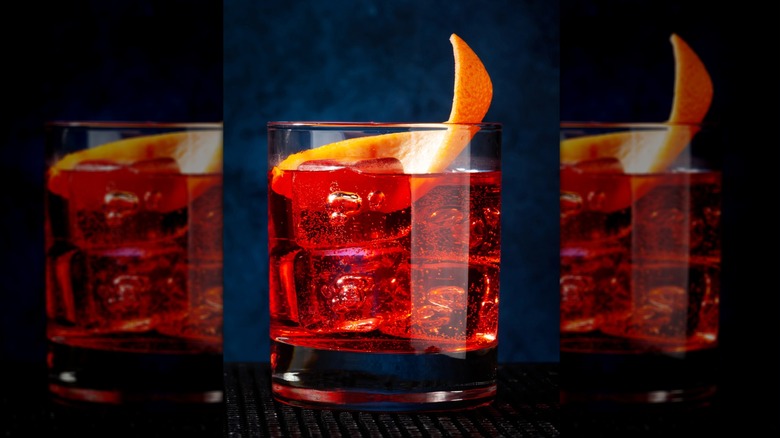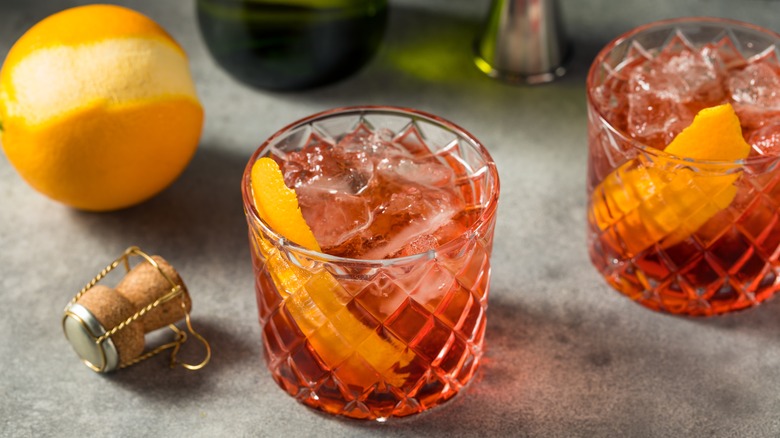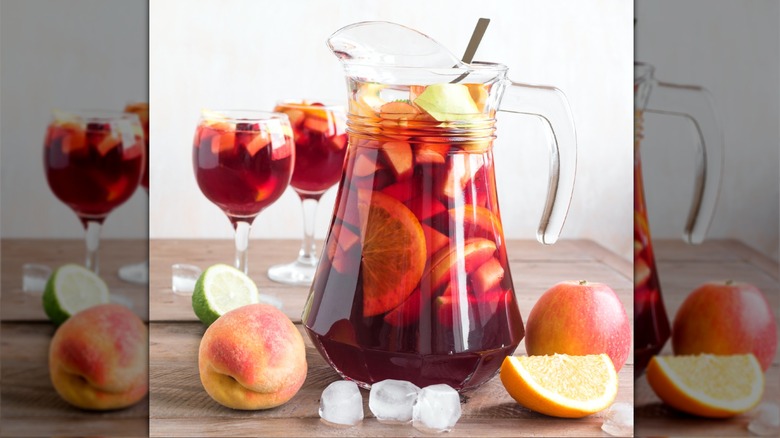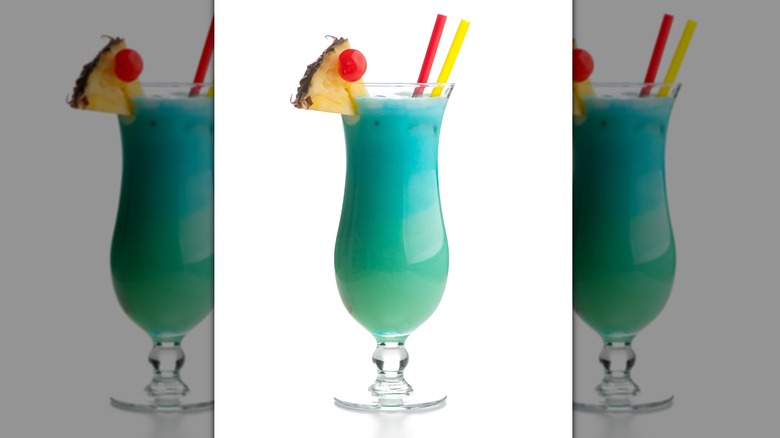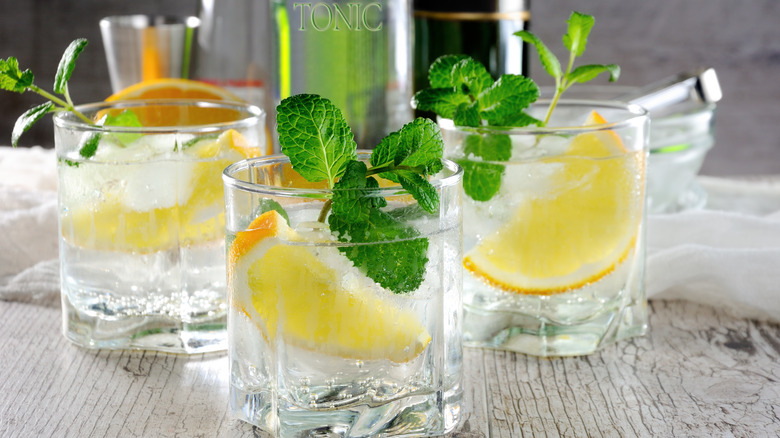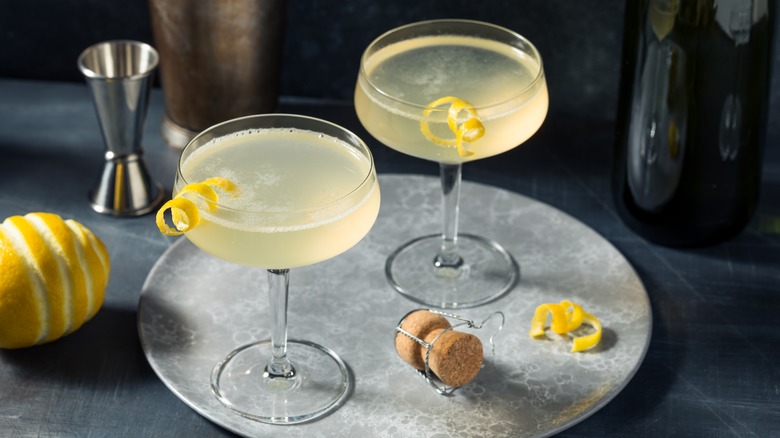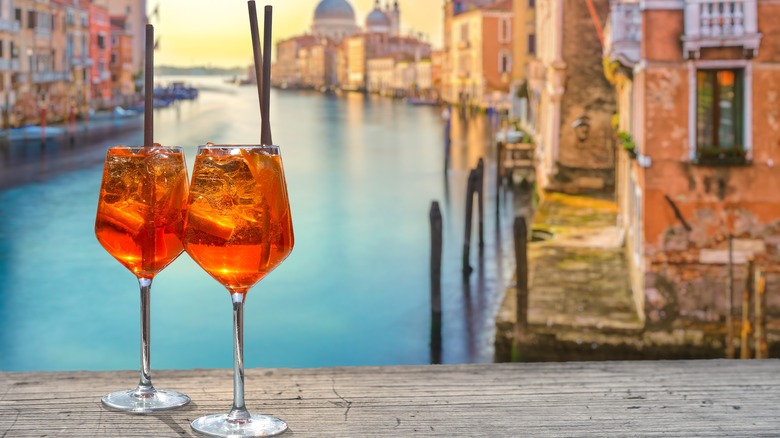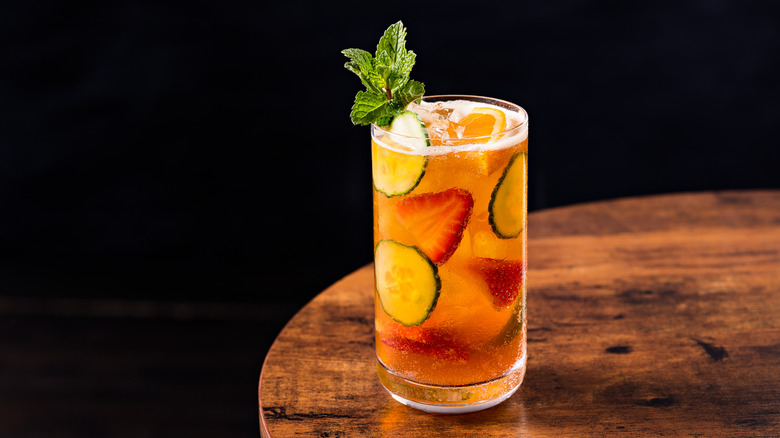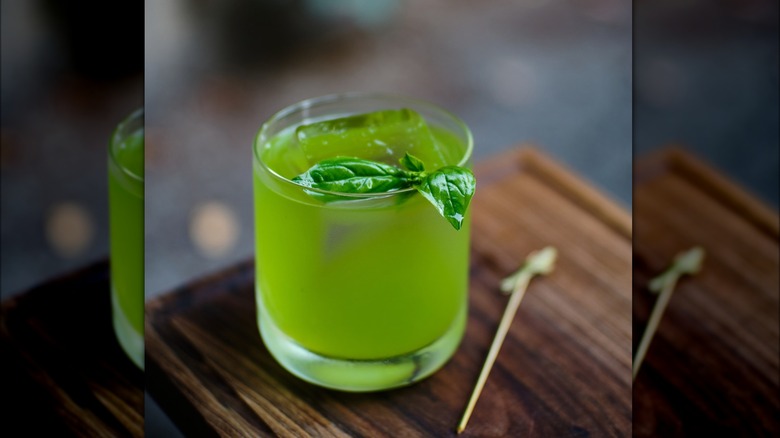13 European Cocktails Experts Say You Need To Try At Least Once
Aside from booking a month-long overseas vacation, immersing yourself in the food and drinks of countries across Europe is one of the best ways to get to know the region and its many cultures. You know about pizza, bratwurst, and fish and chips, but you might be less familiar with the Hugo cocktail, the Swimming Pool, and the Corpse Reviver No. 2. These drinks are just some of the alcoholic beverages that make our list of European drinks you need to get your hands on. To compile our list, we spoke with three experts, Chris Tunstall, the founder of the blog and bar tools store A Bar Above; Camille Wilson, the founder of the blog The Cocktail Snob and author of the book Free Spirit Cocktails; and Kate Schröder, the head bartender at Flora, a bar in Graz, Austria.
If you're wondering how European cocktails differ from cocktails from any other part of the world, Tunstall said that there isn't a specific set of characteristics that distinguish them, but their ingredients sometimes set them apart. "[T]he main difference [between European and American cocktails] will be in the ingredients, from what is accessible to the quality of particular ingredients in specific places," he said, explaining, "Some unique ingredients that exist in Europe may be hard to find in the American market, and vice versa." From bubbly Italian spritzes to an electric blue throwback drink from Germany, here are the European cocktails you have to try at least once.
1. Kir Royale (France)
Adding champagne to a cocktail will always add a big dose of sophistication, and the Kir Royale leans heavily on its bubbly base ingredient. Made with only champagne and the blackcurrant liqueur crème de cassis, it is proof that simplicity can be just as striking as complexity. Crisp from the wine and sweet and tangy from the liquor, it is the perfect cocktail to try when you're looking for something light and classy.
The history of the Kir Royale is a far cry from the easy-breezy experience of drinking it. It emerged during World War II when the Nazis confiscated the famous red wine of Burgundy. Hoping to keep spirits high, a boxing instructor-turned Catholic priest named Felix Kir invented the drink, using raspberry liqueur to give dry white wine a red tinge reminiscent of Burgundy. The Kir, as it was called, was eventually adapted into the champagne and blackcurrant-based drink we know today, but the priest's name stuck. Kir himself went on to play an integral role in the French Resistance, helping 4,000 prisoners of war escape from a camp near Dijon. He later became the mayor.
The Kir Royale belongs on every cocktail menu. Classically served as an aperitif to whet the appetite, it is a crowd-pleaser that is perfect for elegant dinner parties and outdoor gatherings in the summer.
2. Irish Coffee (Ireland)
Guinness is one of the most famous exports that Ireland has to offer, so it's no surprise that one of the country's most delicious cocktails contains the pitch-black stout. Irish Coffee — a deceptively simple combination of Guinness, coffee, sugar syrup, and whipped cream — is smooth, sweet, and perfectly balanced when the preparation is just right. According to Chris Tunstall, the secret to the perfect Irish Coffee is all about the quality of the ingredients. "Jameson — a classic Irish blended whiskey — is the traditional liquor to use in this cocktail for good reason," he said, "But the other three elements also have a massive influence on this cocktail.
"First, using good-quality, freshly-brewed coffee makes a huge difference because you get better flavor and depth. Second, always use fresh cream on top of the cocktail. It helps to slowly heat the cream and fluff it up as you prepare it; this way, it [won't] melt immediately when topping the hot cocktail with it." For the final element, Tunstall recommended using sugar syrup made from demerara sugar rather than white sugar, because the former provides a more caramelized flavor to complement the Jameson. There are many other cocktails that use coffee, he said, but the top-quality ingredients in an Irish Coffee are what sets this particular drink apart from the competition.
3. Hugo (Italy)
One of the lesser-known European drinks (at least to those across the pond) is the Italian creation known as the Hugo. Made with elderflower liqueur (such as St. Germain), prosecco, sparkling water, and mint, it is invariably served on ice with a slice of lemon or lime and is one of the most refreshing cocktails you can find in Italy or anywhere else. It was invented in 2005 in the South Tyrol region of the country, which shares a striking mountain range with Austria. After a strenuous hike up a craggy peak, it's hard to imagine a drink quite as welcoming as a Hugo when you stumble into a local cafe or bar on aching legs.
As Camille Wilson explained, the Hugo is a version of a spritz, an Italian cocktail made with wine. But, she noted that the elderflower liqueur is the main ingredient that distinguishes it from more well-known spritzes like the Aperol Spritz. "A lot of people often associate spritzes with just Aperol, which is bitter and citrus-forward," she said, "So the Hugo spritz being sweet with floral notes and no bitterness makes it stand out."
4. Corpse Reviver No. 2 (UK)
As far as names go, the Corpse Reviver is both attention-grabbing and potentially one of the most off-putting you'll come across. No one wants the word "corpse" associated with anything they're about to consume, but that hasn't deterred cocktail enthusiasts from favoring this particular drink for more than a century. In the late 19th century, corpse revivers did not refer to a single cocktail but to a whole category. Known for their alleged ability to bring someone out of a death-like sleep incurred from a night of hard drinking, corpse revivers were the quintessential hair-of-the-dog treatment, the supposed cure to all hangovers.
These days, the Corpse Reviver No. 2 is probably the most well-known of these old-fashioned concoctions. Made with gin, the French aperitif Lillet Blanc, orange liqueur, and fresh lemon juice, it also features the faint taste of absinthe, which is traditionally used to rinse the glass. A dash of absinthe will work as well. With bitterness from the Lillet Blanc and the acquired taste of absinthe, the Corpse Reviver No. 2 is powerful, citrusy, and possibly not for everyone. But it also provides a tried-and-true balance of flavors that might win you over even if you don't like them individually.
5. Negroni (Italy)
When asked what his favorite European cocktail was, Chris Tunstall was unequivocal. "Negroni. Hands down," he said, noting that, ironically, it is based on an American cocktail, the Americano. "But the history is muddy and contentious," he said. "[A]nd all of its ingredients originated in Europe; so for all intents and purposes, it's European. I love this cocktail because it's expressive and complex and yet so simple. It consists of just three ingredients; but within those three parts, there are seemingly-endless substitutions you can use. And nine times out of 10, it will remain balanced, complex, and delicious!" Those three ingredients? Gin, Campari, and sweet vermouth.
Powerful, bitter, and sweet, the Negroni is a go-to drink for cocktail aficionados and anyone who loves strong, complex drinks. It was allegedly invented in a Florence, Italy bar in 1919, when the impressively named Count Camillo Negroni asked the bartender to make his Americano stronger by replacing the sparkling water with gin. The resulting beverage became so popular over the next few decades that the likes of film auteur Orson Welles were championing it. Ask for a Negroni at an upscale bar these days and you're likely to get an approving nod from the bartender.
6. Negroni Sbagliato (Italy)
If Negronis are a little too intense for your palate, the Negroni Sbagliato (sbagliato meaning "mistaken" in Italian) might be just the ticket. Substituting the gin with prosecco, it is much lower in alcohol content but not quite as low as the Americano, which uses soda water in place of gin or prosecco. Because of this, Chris Tunstall explained that it qualifies as a session cocktail, which is a drink meant to be consumed over a longer period without making you drunk. "Traditionally, [t]he Sbagliato version is made with prosecco, which is a very approachable sparkling wine that's not too sweet or too dry, but which exhibits citrusy notes with a touch of stone fruit like apples and pears," he said. "These flavors are reflected quite well in the cocktail, making it feel lighter and brighter."
However, Tunstall, a die-hard fan of the classic Negroni, says that he has one gripe about the traditional Sbagliato recipe — removing the gin. "First, you're adding another sweetening element to the cocktail without getting rid of the other," he explained. "Second, [g]in and prosecco are a lovely match and complement each other very, very well. They should stay together!" If you're making a Sbagliato at home, Tunstall advised substituting the prosecco for the sweet vermouth instead, explaining that you will end up with "a much more complex and balanced cocktail."
7. Sangria (Spain)
One of the most famous European cocktails is sangria. Hailing from the culinary wonderland of Spain, it is fruity, sweet, and strong, perfect for a summer picnic. It is so popular, in fact, that many devotees of the drink might not even know of its European origins. Made with wine (red or white), fruit juice (usually orange), sugar, sparkling water, sliced fruit, and liqueur (often brandy or cognac), it doesn't have a particularly strict definition. According to Camille Wilson, this is one of its greatest selling points. "Sangria is so versatile!" she said, adding, "I think it's popular around the world because it's fairly easy to make as long as you have a pitcher or punch bowl. Additionally, it's extremely customizable and tends to be a crowd pleaser."
Its lack of a strict definition is not surprising considering how long ago it was created. The Greeks and Romans were mixing wine with fruit and spices nearly 2,000 years ago, marking the earliest variations of both sangria and mulled wine. It likely wasn't until the 1800s that Americans got their first taste of the delicious punch, but it's been something of a love affair ever since. Whether you're touring Madrid or attending a picnic in the U.S. in July, you're likely to find some variation of the beverage on offer. If you're making it at home, make sure to read our guide on the mistakes everyone makes with sangria and how to avoid them.
8. Swimming Pool (Germany)
The Swimming Pool is a playful, eye-catching drink hailing from Germany. According to bartender Kate Schröder, it has a distinctly retro feel about it and is now mostly seen as a nostalgic symbol of the '80s rather than a popular cocktail for modern drinkers. Aside from its electric blue color, it is similar to a piña colada, featuring vodka, white rum, pineapple juice, cream, and Blue Curaçao, a neon blue orange liqueur. Some recipes also call for coconut cream to heighten the piña colada connection. Sweet and tropical, it might evoke a beachy summer feel more than a European bar vibe for those who have never tried it.
According to Schröder, the German cocktail scene has moved in the opposite direction from its vibrantly-hued creation of the 1980s. Bartenders are focusing more on flavor than appearance, with drinks being "clean and simple and not pompously flashy like it was in the '80s." For a sweet, over-the-top summer cocktail, however, the Swimming Pool remains unapologetically garish. For novelty alone, it's worth trying at least once.
9. Porto Tónico (Portugal)
In the heat of the Portuguese summer, nothing hits the spot like the Porto Tónico. For those who are familiar with port as a sweet, deep red dessert wine, it may come as a surprise that this cocktail is a light, almost transparent aperitif. Porto Tónico is made with white port, which is lighter and more acidic than red port, giving the drink a refreshing quality that is perfect for pre-dinner festivities. The only other ingredient in the cocktail is tonic water, hence the name, which translates to port tonic.
Despite its simplicity, the Porto Tónico is deeply satisfying. The inclusion of tonic will inevitably draw comparisons to the gin and tonic, but white port lacks the botanical quality and bitterness of gin. It also has a lower alcohol content at about 20% alcohol by volume compared to around 40% for gin. If you're looking for a refreshing, fizzy drink to enjoy over the course of a few hours on a summer afternoon without waking up with a hangover the next day, it's tough to beat the Porto Tónico.
10. French 75 (France)
For Camille Wilson, no European cocktail can beat the French 75. Made with gin, fresh lemon juice, sugar, and Champagne, it is bright and bubbly with just the right amount of acidity from the lemon and bitterness from the gin. It was invented in Paris sometime during World War I, when the rapid-fire 75-millimeter field gun known simply as the "75" or "Soixante-Quinze" was giving the French army an edge on the battlefield. Naming a drink after the weapon was thought to be a feisty show of patriotism, and, according to journalists and drinkers at the time, an accurate analogy to the swift effect the cocktail had on those who imbibed. Violent origins aside, the drink is elegant and balanced, the ideal beverage to serve on special occasions.
"I love a French 75 because it is simple to make but feels like a celebration in a glass," Wilson said. "In addition to having gin as the base spirit, it's stopped with sparkling wine, which sets it apart and makes it feel extra special. I love hosting at home and I've served mini versions of it as a welcome drink to guests. They love it!"
11. Aperol Spritz (Italy)
The Aperol Spritz is an institution. Featured on restaurant and bar menus the world over, it has expanded far beyond its native Italy, and Chris Tunstall has an easy explanation for why it has become so ubiquitous: "Simply put, it's so darn refreshing," he said. "There are few cocktails that are perfectly synonymous with vacation and relaxing beachside on the idyllic Mediterranean shores, given its light, bright, and refreshing profile." Made with the bright orange bittersweet aperitif Aperol, prosecco, and sparkling water, it is the ideal drink for summertime sipping.
Spritzes have been around since the 1800s, when Austrians in Northern Italy found the local wines too strong for their palates and lightened the alcohol with water. It wasn't until Aperol was invented in 1919 that the spritz hit its stride. It might be famous around the world, but Tunstall explained that the most celebrated variation of the spritz category is still Italian, through and through. "The Aperol Spritz best reflects the touristy parts of the Italian drinking culture," he explained. "But that's not to say that Italians on vacation don't enjoy a good Spritz or two. Although there is no competing with the traditional wine-drinking culture in Italy (or France, for that matter), the Aperol Spritz kind of bridges that gap since it includes both sparkling wine and an aperitif."
12. Pimm's Cup (UK)
If you're attending a garden party in England on a gloriously sunny July afternoon, perhaps wearing one of those enormous decorative hats that befit such an occasion, you may find yourself being offered that most English of summer drinks, a Pimm's Cup. Consisting of the gin-based liquor called Pimm's No 1., ginger ale, lemon juice, fresh strawberries, cucumber slices, and mint leaves, nothing screams Wimbledon chic quite like it. Lightly boozy and oh-so refreshing, it's the perfect drink for sipping all afternoon.
Camille Wilson noted that it hits some of the same notes as a sangria, with the major difference being that the latter is wine-based. Like sangria, a Pimm's Cup is garnished with fruits and is often consumed on hot summer afternoons. The Pimm's Cup is arguably more refreshing, however, due to the inclusion of cucumber and the fizzy spice of the ginger ale. Pimm's No. 1 also provides a more crisp, botanical base than wine, featuring not only gin, but a mixture of herbs, fruit, and spices that give it a unique and heady flavor.
13. Basil Smash (Germany)
A more modern German cocktail that Kate Schröder said everyone should try is the Basil Smash. She identified it as probably the most well-known German cocktail and one that is perfect for summer. It was created by bartender Jörg Meyer in Hamburg in 2008 and was originally known by the slightly less appetizing name, Gin Pesto. Made with basil, gin, lemon juice, and sugar syrup, it is full of clean, zesty flavors and a hint of sweetness. While you might balk at the amount of basil the recipe calls for, you need all of it in order to provide just the right flavor and a deep green color. The drink falls within the "smash" category of cocktails, which are made by muddling (lightly mashing) a type of herb with the other ingredients. Mint is the traditional herb of choice, exemplified by the Whiskey Smash, but basil, with its citrusy, peppery flavor, is equally versatile.
More than a decade after its creation, the Basil Smash is so popular around the world that you don't have to travel to Germany to have it expertly made for you. Many bars outside Europe now feature it, especially in the summer, and since it requires few ingredients and a relatively easy method of preparation, you can also make it in the comfort of your own home.
